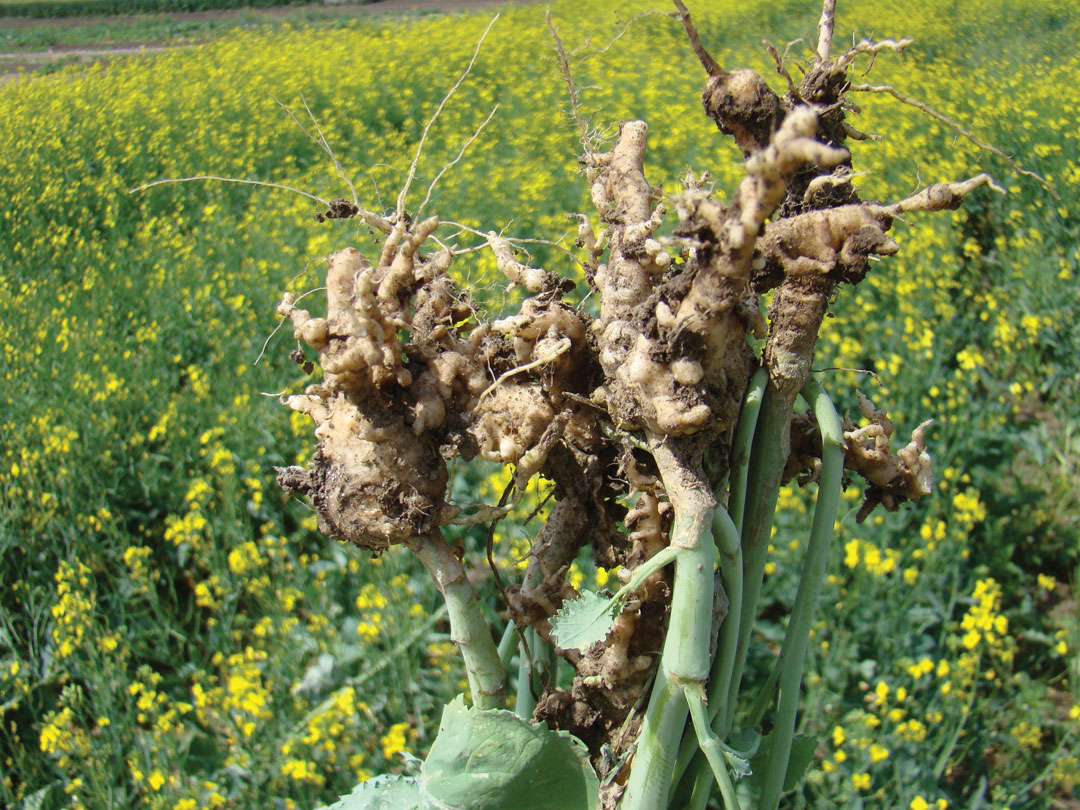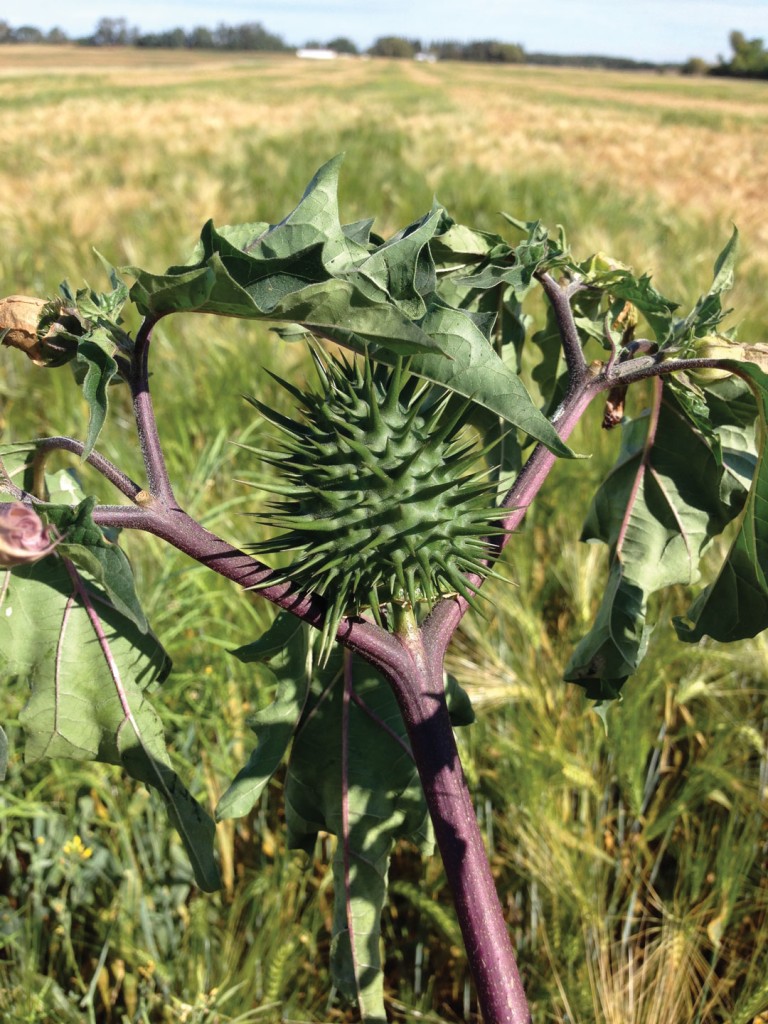PEST PROBLEMS INTENSIFIED BY DRY GROWING SEASON
BY NATALIE NOBLE
A distinct lack of rainfall throughout Alberta in 2015 was not conducive to starting crops off well or keeping them going. On top of this, a long mid-summer drought allowed pests to get ahead of some crops. However, in most cases, weather conditions last season did not allow pests and disease to reach epidemic proportions or severely affect yields.
“Right through into July, growers were fairly pessimistic about the possibilities for their crop,” Canola Council of Canada agronomist Keith Gabert said. “The surprising message for the year from the Canola Council’s perspective is that a lot of growers came back saying they had better yields than expected from the way the year shaped up.”
While pests always present a struggle, the major issue last season was a thinner crop lacking in stand establishment. This gave weeds a chance to grow up and out of the crop more than usual later in the season.
“Weeds were there to take advantage of some extra space and nutrients where normally the crop would’ve choked them out later in the season,” Gabert said. “This made deciding when to spray more difficult.”
On top of thinner crops, the dry conditions made drought-tolerant perennial weeds more troublesome.
“Jimson weed became evident in late fall when it began to tower over the crop and drew attention from farmers while swathing,” Alberta Agriculture and Forestry weed specialist Nicole Kimmel said. “While most cases were found in canola, it also showed up in some other crops.”
Kimmel cautioned growers about jimson weed’s ability to spread if not addressed, and encouraged them to report occurrences to their local fieldperson or Alberta Agriculture (1-403-310-FARM). When removing the plants, producers should take the following precautions: wear gloves and long sleeves to minimize toxin exposure, double bag for landfill disposal, and do not compost or burn jimson weed. In terms of best management practices, it helps to employ a canola-cereal crop rotation.
Like weeds, insects and their potential for destruction are also tied to the environment. When the weather stunts plant growth, insects can have more prevalent effects than normal. For canola, Gabert said that the striped flea beetle was a concern last year, although this varied field by field.
“Flea beetles are an expected issue in some areas every year. The problem was that the crop didn’t grow fast enough to get ahead of them. Usually a few bites won’t cause difficulty, but in some cases, with the year’s slowly established crop, flea beetles were able to gain an advantage over it,” he said. “This would probably be the single largest insect pest of the year.”
Flea beetle bites may appear worse than they really are upon first glance, especially in cases where a single leaf has multiple bites. However, canola crops can take up to 50 per cent leaf damage and still come back.
“I sometimes joke with growers that it’s easier to have an outsider assess for flea beetle damage because the threshold for controlling action is at about 25 per cent leaf damage, and this can look a lot worse than it really is,” Gabert said.
Further concern with flea beetles comes in abnormally cool, windy growing seasons when the insect moves down along the soil to warmer temperatures and chews on stems. Farmers are encouraged to check for stem damage as well as leaf damage.
Monitoring the crop to decide if additional management is required is essential to managing insects. In the case of flea beetles, this scouting is often required at a time when growers are likely still seeding other crops. “The key is that the crop look a little better each and every time you inspect it,” Gabert said. “If not, it’s time to do some detective work.”
Reports of flea beetle damage and some spraying to control the pest came from across the province in 2015.
The crop year also saw grasshoppers present north and east of Edmonton and in the Peace Region, with intense populations and higher numbers due to the cooler dry weather in those areas. Their effects were also intensified on less developed plants.
On the disease front, clubroot, blackleg and sclerotinia were particularly noticeable in canola. While cases of blackleg have increased year over year, researchers said new clubroot infections might have come down due to the weather.
There were also cereal fields in southern Alberta confirmed positive for aster yellows in the mid-season, as well as wheat streak mosaic virus. Because insects spread mosaic virus and aster yellows, they can be driven by heat rather than rain, so the hot, dry summer of 2015 was a factor.
“In most cases we saw symptoms, but not severe damage or an effect on yield,” said Alberta Agriculture plant pathology research scientist Michael Harding. “There were, however, a small number of fields in southern Alberta where the effects of mosaic virus were reaching the threshold of economic importance.”
In heavily infected fields where grain yield might be reduced, Harding suggested producers cut, bale and sell the crop as green feed. “That’s not a bad option right now with the current value of green feed,” he said.
Producers can help prevent pathogens like mosaic virus from bridging the winter in winter wheat through strategic field selection and rotation.
While experts agreed that prevention is the best method of controlling all pests and disease, the reality is that sometimes intervention is necessary. Scouting is one of the most essential steps to determining what’s needed, and then monitoring the progress. “It’s a good idea for producers to be aware of which diseases and pests are present, and at what level, to know if their practices are helping, or if a problem is getting worse,” Harding said.
Looking back on the 2015 growing season can give some indication of what Alberta’s growers should be on the lookout for this year in terms of pests and disease. To start with, items on the regulated lists of the Agricultural Pests Act of Alberta are always of interest to researchers, and there are ongoing surveys for clubroot, blackleg and Fusarium graminearum. There is also potential for management of stripe rust, sclerotinia and root rots. Harding’s team focuses on regulated pests, but they also watch for other issues, often receiving samples for diagnosis from producers.
Last season’s grasshopper numbers suggest the insect could be a concern this season, if the right conditions are in place. “A warm and fairly dry fall could mean lots of egg laying and the possibility of further development, setting us up for problems in the upcoming spring,” said Alberta Agriculture and Forestry insect management specialist Scott Meers. “Especially if we have a warm, dry spring. If we have a wet spring, then at least the crop seems to get ahead of them.”
Meers also said that although cabbage seedpod weevil numbers had been lower in the last couple of years, they were back up to normal in 2015. With its continued slow expansion north and east each year, researchers and growers will be watching out for it in the area south of Highway 1.
With uncharacteristic rainfall and temperature from previous years, the 2015 growing season meant a change in environment that influenced the impact diseases and pests had on crops. Growers can only hope that this year Mother Nature is more co-operative.
“For 2016, we’re really hoping for a return to normal rainfall and a nice spring to make sure our crop looks better early in the season than it did last year,” Gabert said.








Comments